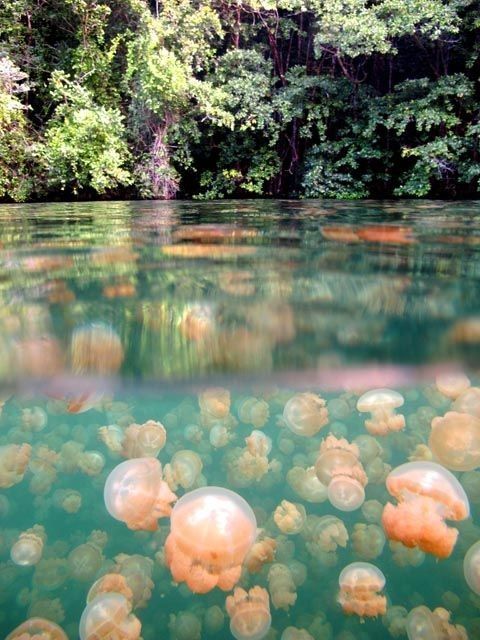What Did These Penguins Do To The Scientists To Deserve This

what did these penguins do to the scientists to deserve this
More Posts from Plutoisnotaplanet and Others
a “hypothesis”, or a “science headcanon”,

Jellyfish Lake in Palau. Apparently the jellies have lost their ability to sting because of lack of predators in the lake and you can swim with them!
It’s Friday...Come Space Out with Us
It’s Friday…which seems like a great excuse to take a look at some awesome images from space.
First, let’s start with our home planet: Earth.

This view of the entire sunlit side of Earth was taken from one million miles away…yes, one MILLION! Our EPIC camera on the Deep Space Climate Observatory captured this image in July 2015 and the picture was generated by combining three separate images to create a photographic-quality image.
Next, let’s venture out 4,000 light-years from Earth.

This image, taken by the Hubble Space Telescope, is not only stunning…but shows the colorful “last hurrah” of a star like our sun. This star is ending its life by casting off its outer layers of gas, which formed a cocoon around the star’s remaining core. Our sun will eventually burn out and shroud itself with stellar debris…but not for another 5 billion years.
The material expelled by the star glows with different colors depending on its composition, its density and how close it is to the hot central star. Blue samples helium; blue-green oxygen, and red nitrogen and hydrogen.
Want to see some rocks on Mars?

Here’s an image of the layered geologic past of Mars revealed in stunning detail. This color image was returned by our Curiosity Mars rover, which is currently “roving” around the Red Planet, exploring the “Murray Buttes” region.
In this region, Curiosity is investigating how and when the habitable ancient conditions known from the mission’s earlier findings evolved into conditions drier and less favorable for life.
Did you know there are people currently living and working in space?

Right now, three people from three different countries are living and working 250 miles above Earth on the International Space Station. While there, they are performing important experiments that will help us back here on Earth, and with future exploration to deep space.
This image, taken by NASA astronaut Kate Rubins shows the stunning moonrise over Earth from the perspective of the space station.
Lastly, let’s venture over to someplace REALLY hot…our sun.

The sun is the center of our solar system, and makes up 99.8% of the mass of the entire solar system…so it’s pretty huge. Since the sun is a star, it does not have a solid surface, but is a ball of gas held together by its own gravity. The temperature at the sun’s core is about 27 million degrees Fahrenheit (15 million degrees Celsius)…so HOT!
This awesome visualization appears to show the sun spinning, as if stuck on a pinwheel. It is actually the spacecraft, SDO, that did the spinning though. Engineers instructed our Solar Dynamics Observatory (SDO) to roll 360 degrees on one axis, during this seven-hour maneuver, the spacecraft took an image every 12 seconds.
This maneuver happens twice a year to help SDO’s imager instrument to take precise measurements of the solar limb (the outer edge of the sun as seen by SDO).
Thanks for spacing out with us…you may now resume your Friday.
Make sure to follow us on Tumblr for your regular dose of space: http://nasa.tumblr.com

would pluto really use the word plox???
so this happened
How to Safely Watch the Aug. 21 Solar Eclipse
On Aug. 21, 2017, a solar eclipse will be visible in North America. Throughout the continent, the Moon will cover part – or all – of the Sun’s super-bright face for part of the day.

Since it’s never safe to look at the partially eclipsed or uneclipsed Sun, everyone who plans to watch the eclipse needs a plan to watch it safely. One of the easiest ways to watch an eclipse is solar viewing glasses – but there are a few things to check to make sure your glasses are safe:
Glasses should have an ISO 12312-2 certification
They should also have the manufacturer’s name and address, and you can check if the manufacturer has been verified by the American Astronomical Society
Make sure they have no scratches or damage

To use solar viewing glasses, make sure you put them on before looking up at the Sun, and look away before you remove them. Proper solar viewing glasses are extremely dark, and the landscape around you will be totally black when you put them on – all you should see is the Sun (and maybe some types of extremely bright lights if you have them nearby).
Never use solar viewing glasses while looking through a telescope, binoculars, camera viewfinder, or any other optical device. The concentrated solar rays will damage the filter and enter your eyes, causing serious injury. But you can use solar viewing glasses on top of your regular eyeglasses, if you use them!

If you don’t have solar viewing glasses, there are still ways to watch, like making your own pinhole projector. You can make a handheld box projector with just a few simple supplies – or simply hold any object with a small hole (like a piece of cardstock with a pinhole, or even a colander) above a piece of paper on the ground to project tiny images of the Sun.

Of course, you can also watch the entire eclipse online with us. Tune into nasa.gov/eclipselive starting at noon ET on Aug. 21!
For people in the path of totality, there will be a few brief moments when it is safe to look directly at the eclipse. Only once the Moon has completely covered the Sun and there is no light shining through is it safe to look at the eclipse. Make sure you put your eclipse glasses back on or return to indirect viewing before the first flash of sunlight appears around the Moon’s edge.

You can look up the length of the total eclipse in your area to help you set a time for the appropriate length of time. Remember – this only applies to people within the path of totality.
Everyone else will need to use eclipse glasses or indirect viewing throughout the entire eclipse!
Photographing the Eclipse
Whether you’re an amateur photographer or a selfie master, try out these tips for photographing the eclipse.

#1 — Safety first: Make sure you have the required solar filter to protect your camera.
#2 — Any camera is a good camera, whether it’s a high-end DSLR or a camera phone – a good eye and vision for the image you want to create is most important.
#3 — Look up, down, and all around. As the Moon slips in front of the Sun, the landscape will be bathed in long shadows, creating eerie lighting across the landscape. Light filtering through the overlapping leaves of trees, which creates natural pinholes, will also project mini eclipse replicas on the ground. Everywhere you can point your camera can yield exceptional imagery, so be sure to compose some wide-angle photos that can capture your eclipse experience.
#4 — Practice: Be sure you know the capabilities of your camera before Eclipse Day. Most cameras, and even many camera phones, have adjustable exposures, which can help you darken or lighten your image during the tricky eclipse lighting. Make sure you know how to manually focus the camera for crisp shots.
#5 —Upload your eclipse images to NASA’s Eclipse Flickr Gallery and relive the eclipse through other peoples’ images.
Learn all about the Aug. 21 eclipse at eclipse2017.nasa.gov, and follow @NASASun on Twitter and NASA Sun Science on Facebook for more. Watch the eclipse through the eyes of NASA at nasa.gov/eclipselive starting at 12 PM ET on Aug. 21.
Make sure to follow us on Tumblr for your regular dose of space: http://nasa.tumblr.com

lol watch irma try to run up on me…
-
 the-latchkey-kid reblogged this · 1 week ago
the-latchkey-kid reblogged this · 1 week ago -
 brick3621 liked this · 2 weeks ago
brick3621 liked this · 2 weeks ago -
 mellokie liked this · 3 weeks ago
mellokie liked this · 3 weeks ago -
 sleepinthesoil liked this · 2 months ago
sleepinthesoil liked this · 2 months ago -
 panthera-leo-persica liked this · 3 months ago
panthera-leo-persica liked this · 3 months ago -
 vehiculartheyslaughter liked this · 3 months ago
vehiculartheyslaughter liked this · 3 months ago -
 flipfloptime reblogged this · 3 months ago
flipfloptime reblogged this · 3 months ago -
 flipfloptime liked this · 3 months ago
flipfloptime liked this · 3 months ago -
 south-africa-official reblogged this · 4 months ago
south-africa-official reblogged this · 4 months ago -
 mightylaaitie liked this · 4 months ago
mightylaaitie liked this · 4 months ago -
 south-africa-official reblogged this · 4 months ago
south-africa-official reblogged this · 4 months ago -
 ye-olde-party-times reblogged this · 4 months ago
ye-olde-party-times reblogged this · 4 months ago -
 ye-olde-party-times liked this · 4 months ago
ye-olde-party-times liked this · 4 months ago -
 daengeli liked this · 4 months ago
daengeli liked this · 4 months ago -
 elytran101 reblogged this · 5 months ago
elytran101 reblogged this · 5 months ago -
 katmaybee liked this · 5 months ago
katmaybee liked this · 5 months ago -
 annita89n0mf78lh liked this · 6 months ago
annita89n0mf78lh liked this · 6 months ago -
 annai9lwq liked this · 6 months ago
annai9lwq liked this · 6 months ago -
 ratsconfusion liked this · 6 months ago
ratsconfusion liked this · 6 months ago -
 theravenclawandthewritingdesk reblogged this · 6 months ago
theravenclawandthewritingdesk reblogged this · 6 months ago -
 thedragonofthemidwest liked this · 6 months ago
thedragonofthemidwest liked this · 6 months ago -
 wikipediaboyf reblogged this · 7 months ago
wikipediaboyf reblogged this · 7 months ago -
 slasherslut883 liked this · 7 months ago
slasherslut883 liked this · 7 months ago -
 combingthedesert reblogged this · 9 months ago
combingthedesert reblogged this · 9 months ago -
 67-rats-in-a-trenchcoat liked this · 9 months ago
67-rats-in-a-trenchcoat liked this · 9 months ago -
 nixieniade liked this · 9 months ago
nixieniade liked this · 9 months ago -
 scp-threats-is-back liked this · 10 months ago
scp-threats-is-back liked this · 10 months ago -
 theleastofweasels reblogged this · 10 months ago
theleastofweasels reblogged this · 10 months ago -
 chillonah liked this · 10 months ago
chillonah liked this · 10 months ago -
 name-undergoing-transition reblogged this · 10 months ago
name-undergoing-transition reblogged this · 10 months ago -
 miifighter reblogged this · 10 months ago
miifighter reblogged this · 10 months ago -
 baseless-eldritch-horror-facts liked this · 10 months ago
baseless-eldritch-horror-facts liked this · 10 months ago -
 thederpyrainicorn reblogged this · 11 months ago
thederpyrainicorn reblogged this · 11 months ago -
 3-furbies-in-a-trench-coat liked this · 11 months ago
3-furbies-in-a-trench-coat liked this · 11 months ago -
 redbarn1995 liked this · 11 months ago
redbarn1995 liked this · 11 months ago -
 monicanna-mess reblogged this · 11 months ago
monicanna-mess reblogged this · 11 months ago -
 nikipuppeteer reblogged this · 11 months ago
nikipuppeteer reblogged this · 11 months ago -
 nikipuppeteer liked this · 11 months ago
nikipuppeteer liked this · 11 months ago -
 pikosstuff reblogged this · 11 months ago
pikosstuff reblogged this · 11 months ago -
 bookwyrmth1rt33n reblogged this · 11 months ago
bookwyrmth1rt33n reblogged this · 11 months ago -
 bookwyrmth1rt33n liked this · 11 months ago
bookwyrmth1rt33n liked this · 11 months ago -
 thesaltofcarthage reblogged this · 11 months ago
thesaltofcarthage reblogged this · 11 months ago -
 sandraharissa reblogged this · 11 months ago
sandraharissa reblogged this · 11 months ago -
 c4ttyc4t reblogged this · 1 year ago
c4ttyc4t reblogged this · 1 year ago -
 c4ttyc4t liked this · 1 year ago
c4ttyc4t liked this · 1 year ago -
 skittles6815 reblogged this · 1 year ago
skittles6815 reblogged this · 1 year ago
welcome to my space space (see what i did there) (space means two different things)
232 posts

